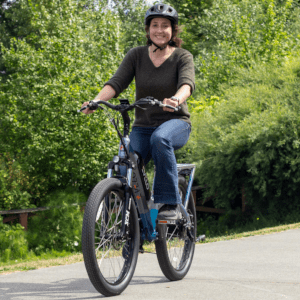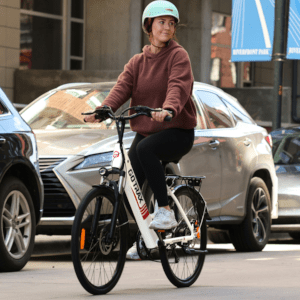 A bill which was recently introduced in California would ban children under the age of 12 from riding electric bicycles, and would require those 12 or older to either possess a valid driver’s license or proof they passed an electric bicycle safety course in order to ride electric bikes in California.
A bill which was recently introduced in California would ban children under the age of 12 from riding electric bicycles, and would require those 12 or older to either possess a valid driver’s license or proof they passed an electric bicycle safety course in order to ride electric bikes in California.
The Proposed Bill
The e-bike bill, which was introduced by Assemblywoman Tasha Boerner on February 8, would:
- Ban children under the age of 12 from operating e-bikes of any class
- Require that e-bike riders possess either a valid driver’s license or proof of passing an e-bike safety course in order to ride e-bikes
- Require that those who ride electric bicycles carry valid photo identification while riding e-bikes
The bill would require California e-bike riders who don’t have valid driver’s licenses to complete training programs which are based upon practices which are evidence-based regarding the use of e-bikes, including general safety regarding riding e-bikes, emergency maneuvering skills, e-bike laws and traffic laws.
E-Bike Safety Issues
In September 2023, the United States Consumer Product Safety Commission (CPSC) released a report on injuries and deaths related to three micromobility products: electric bicycles, electric scooters and hoverboards.
According to the report, electric bicycles were the involved in about 53,200 emergency room visits during the time span from 2017 through 2022. The report also states that 104 fatalities involving e-bikes occurred during that same time span.
The report states that the top hazards which were associated with electric bicycle fatalities were control issues and accidents involving motor vehicles. Collisions involving motor vehicles accounted for 58 of the reported deaths, and control issues like crashing into fixed objects and striking road curbs were responsible for 16 of the reported deaths.
Two riders of e-bikes died after striking pedestrians, and six pedestrians dies after being struck by electric bicycles.
Two deaths were reported in connection with residential fires which were started by electric bicycle batteries.
One fatality was reported involving a rider who hit a speed bump and went airborne, then crash-landed.
The report also states that 28 fire hazard problems were reported to the CPSC regarding e-bikes during the time span from 2017 through 2022. Most of these fires occurred while the electric bicycles were undergoing charging.
What Is an E-Bike?
E-bikes, according to California’s vehicle code, are defined as bicycles which are equipped with pedals which are fully operable, as well as electric motors which are under 750 watts.
The vehicle code breaks down e-bikes into three separate e-bike classifications:
- Class 1: These e-bikes only provide assistance when the rider pedals, and stop providing assistance once a speed of 20 miles per hour is reached
- Class 2: These e-bikes operate via throttle or pedal-assist, and stop providing assistance once a speed of 20 miles per hour is reached
- Class 3: These e-bikes only provide assistance when the rider pedals, and stop providing assistance once a speed of 28 miles per hour is reached
Existing California E-Bike Laws
 California has laws for motor vehicles which do not necessarily apply to electric bikes. California exempts e-bikes from various requirements and laws which apply to automobiles and motorcycles. Those who operate e-bikes don’t currently require:
California has laws for motor vehicles which do not necessarily apply to electric bikes. California exempts e-bikes from various requirements and laws which apply to automobiles and motorcycles. Those who operate e-bikes don’t currently require:
- Local or state registration
- Operator’s licenses
- License plates
- Motor vehicle insurance
While Class 1 and Class 2 e-bikes don’t currently have age restrictions, children under the age of 16 cannot ride Class 3 e-bikes.
Everyone who rides Class 3 e-bikes must wear a helmet.
Anyone who rides any type of bicycle, including electric bikes and regular bikes, must wear a helmet if they are under the age of 18.
E-bike riders are allowed to carry passengers on e-bikes which are set up to carry passengers. Passengers and riders under the age of 18 need to wear helmets. All passengers on Class 3 electric bicycles need to wear helmets.
Cities are prevented by California law from restricting access for e-bike riders to places such as bike paths, bike trails, bike lanes or bikeways. Local authorities can still block e-bikes’ access to recreational trails, hiking trails and equestrian trails.
The use of a bicycle with motor power can be prohibited by any Department of Parks and Recreation on trails or bicycle paths which are in the jurisdiction of the department.
Preventing E-Bike Accidents
There are many ways you can prevent e-bike accidents and prevent injuries in the case of an e-bike accident. These strategies include:
Safety Equipment
It’s critical to use safety gear to minimize potential harm and prevent e-bike accidents. One should wear a helmet that is properly fitted in order to protect their head from injuries during collisions or falls. Lights and reflective clothes can improve one’s visibility in settings with low levels of light.
Wearing strong gloves gives one protection and a firmer grip during abrupt stops or accidents. Knee pads and elbow pads protect one from fractures and abrasions.
Rider Training
Education regarding defensive riding, road awareness and traffic rules is essential for reducing e-bike accidents and ensuring safe e-bike usage.
One can improve their control of e-bikes by learning effective maneuvering, handling and braking techniques. Adequate e-bike training also involves maintenance awareness – this can help riders identify possible problems, helping them avoid breakdowns.
Knowing Traffic Rules
Following speed limits and obeying traffic signals ensures one’s interactions with other users of the road are peaceful, preventing accidents. One can clearly communicate with pedestrians and other drivers by communicating their intentions and maintaining their lane. Possible collisions can be avoided by awareness of forbidden locations, pedestrian crossings and one-way streets.
Defensive Riding
It’s important to adopt a riding style which is defensive in order to ensure safety and avoid accidents. You can reduce your chance of getting in an accident by following cars at a safe distance, anticipating possible risks and paying attention to your surroundings.
Defensive riding involves cautiously managing your speed, especially in bad weather or busy places.
Awareness of Road Conditions
When riding e-bikes, be aware of dangerous roadway conditions like narrow routes, slick roads and potholes to avoid accidents.
Been Injured in an E-Bike Accident? Get in Touch With Our Lawyers
 If you have been injured in an e-bike accident, our experienced bicycle accident law firm can help you recover financial compensation for medical bills, lost wages, pain, suffering and more.
If you have been injured in an e-bike accident, our experienced bicycle accident law firm can help you recover financial compensation for medical bills, lost wages, pain, suffering and more.
We have been helping those injured in bicycle accidents since 1990, having recovered over 0,000,000 for our clients.
If you can’t afford treatment for your e-bike injuries, we can get you to doctors who won’t charge you until your case is over.
We will represent you without charging you any fee until and unless we recover compensation for your e-bike injuries.
Call us today for a free consultation if you or a loved one was injured or killed in an e-bike accident.

